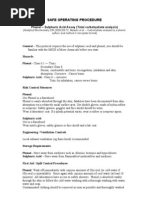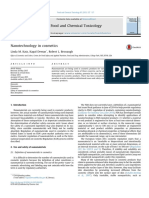Material Downloaded From - 1 / 5
Material Downloaded From - 1 / 5
Uploaded by
Dheeraj Kumar MeenaCopyright:
Available Formats
Material Downloaded From - 1 / 5
Material Downloaded From - 1 / 5
Uploaded by
Dheeraj Kumar MeenaOriginal Description:
Original Title
Copyright
Available Formats
Share this document
Did you find this document useful?
Is this content inappropriate?
Copyright:
Available Formats
Material Downloaded From - 1 / 5
Material Downloaded From - 1 / 5
Uploaded by
Dheeraj Kumar MeenaCopyright:
Available Formats
CBSE
Class 11 Biology
NCERT Solutions
Chapter 1
DIVERSITY IN THE LIVING WORLD
1. Why are living organisms classified?
Ans. A large variety of plants, animals, and microbes are found on earth. All these living
organisms differ in size, shape, colour, habitat, and many other characteristics. As there are
millions of living organisms on earth, studying each of them is impossible. Therefore,
scientists have devised mechanisms to classify all living organisms. These methods of
classification are based on rules and principles that allow identification, nomenclature, and
finally classification of an organism.
Therefore, the biological classification helps in revealing the relationship between various
organisms. It also helps in making study of organisms easy and organized.
2. Why are the classification systems changing every now and then?
Ans. Millions of plants, animals, and microorganisms are found on earth. Many of these have
been identified by the scientists while many new species are still being discovered around
the world. Therefore, to classify these newly discovered species, new systems of classification
have to be devised every now and then. This creates the requirement to change the existing
systems of classification.
3. What different criteria would you choose to classify people that you meet often?
Ans. To classify a class of forty students, let us start the classification on the basis of sexes of
the students. This classification will result in the formation of two major groups- boys and
girls. Each of these two groups can be further classified on the basis of the names of the
students falling in these groups.
Since it is possible that more than one student can have a particular name, these names can
be further divided based on the surnames.
Since there is still some chance that more than one student can have the same surname, the
final level of classification will be based on the roll numbers of each student.
Material downloaded from myCBSEguide.com. 1 / 5
4. What do we learn from identification of individuals and populations?
Ans. The knowledge of characteristics of an individual or its entire population helps in the
identification of similarities and dissimilarities among the individuals of same kind or
between different types of organisms. It helps the scientists to classify organisms in various
categories.
5. Given below is the scientific name of Mango. Identify the correctly written name.
Mangifera Indica
Ans. In binomial system of nomenclature, the generic name of a species always starts with a
capital letter whereas the specific name starts with a small letter. Therefore, the correct
scientific name of Mango is Mangifera indica.
6. Define a taxon. Give some examples of taxa at different hierarchical levels.
Ans. Each unit or category of classification is termed as a taxon. It represents a rank. For
example, the basic level of classification is species, followed by genus, family, order, class,
phylum or division, in ascending order. The highest level of classification is known as
kingdom.
7. Can you identify the correct sequence of taxonomical categories?
(a) Species → Order → Phylum → Kingdom
(b) Genus → Species → Order → Kingdom
(c) Species → Genus → Order → Phylum
Ans. The correct hierarchical arrangement of taxonomic categories in ascending order is
Species → Genus → Family → Order → Class → Phylum → Kingdom
Therefore, both (a) and (c) represent correct sequences of taxonomic categories.
In sequence (b), species should be followed by genus. Therefore, it does not represent the
correct sequence.
8. Try to collect all the currently accepted meanings for the word ‘species'. Discuss with
your teacher the meaning of species in case of higher plants and animals on one hand
and bacteria on the other hand.
Ans. In biological terms, species is the basic taxonomical rank. It can be defined as a group of
Material downloaded from myCBSEguide.com. 2 / 5
similar organisms that are capable of interbreeding under natural conditions to produce
fertile offsprings.
Therefore, a group of similar individuals that are respectively isolated form a species.
Species can also be defined as group of individuals that share the same gene pool.
9. Define and understand the following terms:
(i) Phylum (ii) Class (iii) Family (iv) Order (v) Genus
Ans. (i) Phylum is the primary division of kingdom. It includes one or more related classes of
animals. In plants, instead of phylum, the term ‘division' is used.
(ii) Class is a taxonomic group consisting of one or more related orders. For example, the
class, Mammalia, includes many orders.
(iii) Family is a taxonomic group containing one or more related genera. In plants, families
are categorized on the basis of vegetative and reproductive features.
(iv)Order is a taxonomic group containing one or more families. For example, the order,
carnivore, includes many families.
(v) Genus is a taxonomic group including closely related species. For example, the genus,
Solanum, includes many species such as nigrum, melongena, tuberosum,etc.
10. How is a key helpful in the identification and classification of an organism?
Ans. Key is another taxonomical aid that helps in identification of plant and animal species.
These keys are based on similarities and dissimilarities in characters, generally in a pair
called couplet.Each statement in a taxonomic key is referred to as a lead. For categorizing
each taxonomic rank, such as family, genus, species, etc., different keys are used. It is also
useful in identification of unknown organisms.
Keys are of two types- indented and bracketed keys. Indented key provides a sequence of
choices between two or more statements while in bracketed key, a pair of contrasting
characters are used.
(i) Indented key to identify different species of Rhododendron.
1. Leaves evergreen
2. leaves densely hairy below, orange or white hair; flower appears to have separate petals
....…. Rhododendron groenlandicum
2. hair absent on leaves, flower has five petals fused in a shallow tube ……. Rhododendron
maximus
Material downloaded from myCBSEguide.com. 3 / 5
1. Leaves deciduous
3. pink flowers with two free petals and three fused petals ………. Rhododendron canadense
3. white to pink flowers with all petals fused together
(ii) Bracketed key to identify different species of Rhododendron.
1. Leaves evergreen——2
1. Leaves deciduous——3
2. Leaves densely hairy below, orange or white hair; flower appears to have separate petals ..
…. Rhododendron groenlandicum
2. Hair absent on leaves, flower has five petals fused in shallow tube ...…..Rhododendron
maximus
3. Pink flowers with two free petals and three fused petals ....… Rhododendron canadense
3. White to pink flowers with all petals fused together—–4
11. Illustrate the taxonomical hierarchy with suitable examples of a plant and an
animal.
Ans. The arrangement of various taxa in a hierarchical order is called taxonomic hierarchy.
In this hierarchy, species is present at the lowest level whereas kingdom is present at the
highest level.
Kingdom
↑
Phylum or division
↑
Class
↑
Order
↑
Family
↑
Genus
↑
Species
A Taxonomic hierarchy
Material downloaded from myCBSEguide.com. 4 / 5
Classification of a plant
As an example, let us classify Solanum melongena (Brinjal).
Kingdom – Plantae
Division – Angiospermae
Class – Dicotyledonae
Order – Solanales
Family – Solanaceae
Genus – Solanum
Species – melongena
Classification of an animal
As an example, let us classify Columba livia (Blue rock Dove).
Kingdom – Animalia
Phylum – Chordata
Class – Aves
Order – Columbiformes
Family – Columbidae
Genus – Columba
Species – livia
Material downloaded from myCBSEguide.com. 5 / 5
You might also like
- Biology Why Are Living Organisms Classified?: AnswerNo ratings yetBiology Why Are Living Organisms Classified?: Answer35 pages
- NCERT Solutions For Class 11 Biology Chapter 1 - The Living World - .No ratings yetNCERT Solutions For Class 11 Biology Chapter 1 - The Living World - .5 pages
- Answers NCERT Solutions For Class 11 Biology Part 1 Chapter 1 11No ratings yetAnswers NCERT Solutions For Class 11 Biology Part 1 Chapter 1 1184 pages
- NCERT Solutions For Biology Chapter 1 The Living World Class 11No ratings yetNCERT Solutions For Biology Chapter 1 The Living World Class 116 pages
- Class 11 Biology NCERT Solutions Chapter No 1 - The Living World PDFNo ratings yetClass 11 Biology NCERT Solutions Chapter No 1 - The Living World PDF16 pages
- NCERT Solutions Class 11 Biology Chapter 1No ratings yetNCERT Solutions Class 11 Biology Chapter 13 pages
- Biology Textbook Answers Chapter 1 To 4No ratings yetBiology Textbook Answers Chapter 1 To 423 pages
- Biodiversity: Unit Iv: Module 1 Arnel A. Julaton Sst-INo ratings yetBiodiversity: Unit Iv: Module 1 Arnel A. Julaton Sst-I25 pages
- vt59.2708-21346548946 144960841892483 4204374980529604093 n.pdfGENBIO2 Depthofevolution Forfinalcheck.No ratings yetvt59.2708-21346548946 144960841892483 4204374980529604093 n.pdfGENBIO2 Depthofevolution Forfinalcheck.9 pages
- CBSE Class 11 Biology Chapter 1 The Living World Revision NotesNo ratings yetCBSE Class 11 Biology Chapter 1 The Living World Revision Notes28 pages
- Ncert Solutions Class 11 Biology Chapter 1 The Living World - 0No ratings yetNcert Solutions Class 11 Biology Chapter 1 The Living World - 07 pages
- The Act, Process, or Result of Classifying. A Category or Class. Biology The Systematic Grouping of Organisms Into Categories On The Basis of Evolutionary or Structural Relationships Between ThemNo ratings yetThe Act, Process, or Result of Classifying. A Category or Class. Biology The Systematic Grouping of Organisms Into Categories On The Basis of Evolutionary or Structural Relationships Between Them6 pages
- The Diversion in Living Organisms and Their Overview ClassificationsNo ratings yetThe Diversion in Living Organisms and Their Overview Classifications4 pages
- Class11 Bio AllKeyChapters ForUPSCGovtExamNo ratings yetClass11 Bio AllKeyChapters ForUPSCGovtExam478 pages
- class XI (Chapter -2 Taxonomy and Systematic)No ratings yetclass XI (Chapter -2 Taxonomy and Systematic)15 pages
- Intermediate First Year Neet Zoology MaterialNo ratings yetIntermediate First Year Neet Zoology Material322 pages
- SILENT READING ACTIVITY Grade 8 Module 3No ratings yetSILENT READING ACTIVITY Grade 8 Module 34 pages
- Important Questions Class 11 Biology Chapter 1No ratings yetImportant Questions Class 11 Biology Chapter 19 pages
- Ncert Solutions For Class 11 Chemistry Chapter 1 The Living World - RemovedNo ratings yetNcert Solutions For Class 11 Chemistry Chapter 1 The Living World - Removed7 pages
- Textbook Chap. 1 Characteristics and Classification of Living OrganismsNo ratings yetTextbook Chap. 1 Characteristics and Classification of Living Organisms50 pages
- Lecture 3 - Taxonomy, Systematics, and ClassificationNo ratings yetLecture 3 - Taxonomy, Systematics, and Classification35 pages
- Taxonomy Phylogenetic Tree and Cladistics DISCUSSIONNo ratings yetTaxonomy Phylogenetic Tree and Cladistics DISCUSSION43 pages
- Role of Magnesium, Coenzyme Q, Riboflavin, and Vitamin B in Migraine ProphylaxisNo ratings yetRole of Magnesium, Coenzyme Q, Riboflavin, and Vitamin B in Migraine Prophylaxis16 pages
- Course: BOT - 525 Title: Botany - Service Course Basic Plant Tissue CultureNo ratings yetCourse: BOT - 525 Title: Botany - Service Course Basic Plant Tissue Culture14 pages
- Preparation, Dispensing and Sterilizing of Media For Cultivation of Microorganism100% (1)Preparation, Dispensing and Sterilizing of Media For Cultivation of Microorganism11 pages
- The Design and Manufacture of Medicines: M I C H A E L E - AultoribpharmphdfaapsfrpharmsNo ratings yetThe Design and Manufacture of Medicines: M I C H A E L E - Aultoribpharmphdfaapsfrpharms3 pages
- Liver-specific Gene PGRMC1 Blocks C-Myc-Induced HeNo ratings yetLiver-specific Gene PGRMC1 Blocks C-Myc-Induced He18 pages
- The Principles of Intra-Articular Fracture Care: Joseph Schatzker M.D., B.SC., (Med.), F.R.C.S. (C)No ratings yetThe Principles of Intra-Articular Fracture Care: Joseph Schatzker M.D., B.SC., (Med.), F.R.C.S. (C)31 pages
- Association of Hindiii-Polymorphism in Kappa-Casein Gene With Milk, Fat and Protein Yield in Holstein CattleNo ratings yetAssociation of Hindiii-Polymorphism in Kappa-Casein Gene With Milk, Fat and Protein Yield in Holstein Cattle5 pages
- Namma Kalvi 10th Science Public Exam and PTA Question Papers With Answers EM 221734No ratings yetNamma Kalvi 10th Science Public Exam and PTA Question Papers With Answers EM 22173463 pages
- Virtual Herbarium, Documentation and KeysNo ratings yetVirtual Herbarium, Documentation and Keys12 pages
- Catheter Complication: Managing Pitfalls in IV Therapy: Perawat Hebat - Perawat TangguhNo ratings yetCatheter Complication: Managing Pitfalls in IV Therapy: Perawat Hebat - Perawat Tangguh37 pages
- CBSE Class 10 Science Question Paper 2020 SET 1No ratings yetCBSE Class 10 Science Question Paper 2020 SET 16 pages
- Potential of Neem Leaf Powder As Bio Adsorbents For Dye Colour RemovalNo ratings yetPotential of Neem Leaf Powder As Bio Adsorbents For Dye Colour Removal4 pages
- Biology Why Are Living Organisms Classified?: AnswerBiology Why Are Living Organisms Classified?: Answer
- NCERT Solutions For Class 11 Biology Chapter 1 - The Living World - .NCERT Solutions For Class 11 Biology Chapter 1 - The Living World - .
- Answers NCERT Solutions For Class 11 Biology Part 1 Chapter 1 11Answers NCERT Solutions For Class 11 Biology Part 1 Chapter 1 11
- NCERT Solutions For Biology Chapter 1 The Living World Class 11NCERT Solutions For Biology Chapter 1 The Living World Class 11
- Class 11 Biology NCERT Solutions Chapter No 1 - The Living World PDFClass 11 Biology NCERT Solutions Chapter No 1 - The Living World PDF
- Biodiversity: Unit Iv: Module 1 Arnel A. Julaton Sst-IBiodiversity: Unit Iv: Module 1 Arnel A. Julaton Sst-I
- vt59.2708-21346548946 144960841892483 4204374980529604093 n.pdfGENBIO2 Depthofevolution Forfinalcheck.vt59.2708-21346548946 144960841892483 4204374980529604093 n.pdfGENBIO2 Depthofevolution Forfinalcheck.
- CBSE Class 11 Biology Chapter 1 The Living World Revision NotesCBSE Class 11 Biology Chapter 1 The Living World Revision Notes
- Ncert Solutions Class 11 Biology Chapter 1 The Living World - 0Ncert Solutions Class 11 Biology Chapter 1 The Living World - 0
- The Act, Process, or Result of Classifying. A Category or Class. Biology The Systematic Grouping of Organisms Into Categories On The Basis of Evolutionary or Structural Relationships Between ThemThe Act, Process, or Result of Classifying. A Category or Class. Biology The Systematic Grouping of Organisms Into Categories On The Basis of Evolutionary or Structural Relationships Between Them
- The Diversion in Living Organisms and Their Overview ClassificationsThe Diversion in Living Organisms and Their Overview Classifications
- Ncert Solutions For Class 11 Chemistry Chapter 1 The Living World - RemovedNcert Solutions For Class 11 Chemistry Chapter 1 The Living World - Removed
- Textbook Chap. 1 Characteristics and Classification of Living OrganismsTextbook Chap. 1 Characteristics and Classification of Living Organisms
- Lecture 3 - Taxonomy, Systematics, and ClassificationLecture 3 - Taxonomy, Systematics, and Classification
- Taxonomy Phylogenetic Tree and Cladistics DISCUSSIONTaxonomy Phylogenetic Tree and Cladistics DISCUSSION
- Role of Magnesium, Coenzyme Q, Riboflavin, and Vitamin B in Migraine ProphylaxisRole of Magnesium, Coenzyme Q, Riboflavin, and Vitamin B in Migraine Prophylaxis
- Course: BOT - 525 Title: Botany - Service Course Basic Plant Tissue CultureCourse: BOT - 525 Title: Botany - Service Course Basic Plant Tissue Culture
- Preparation, Dispensing and Sterilizing of Media For Cultivation of MicroorganismPreparation, Dispensing and Sterilizing of Media For Cultivation of Microorganism
- The Design and Manufacture of Medicines: M I C H A E L E - AultoribpharmphdfaapsfrpharmsThe Design and Manufacture of Medicines: M I C H A E L E - Aultoribpharmphdfaapsfrpharms
- Liver-specific Gene PGRMC1 Blocks C-Myc-Induced HeLiver-specific Gene PGRMC1 Blocks C-Myc-Induced He
- The Principles of Intra-Articular Fracture Care: Joseph Schatzker M.D., B.SC., (Med.), F.R.C.S. (C)The Principles of Intra-Articular Fracture Care: Joseph Schatzker M.D., B.SC., (Med.), F.R.C.S. (C)
- Association of Hindiii-Polymorphism in Kappa-Casein Gene With Milk, Fat and Protein Yield in Holstein CattleAssociation of Hindiii-Polymorphism in Kappa-Casein Gene With Milk, Fat and Protein Yield in Holstein Cattle
- Namma Kalvi 10th Science Public Exam and PTA Question Papers With Answers EM 221734Namma Kalvi 10th Science Public Exam and PTA Question Papers With Answers EM 221734
- Catheter Complication: Managing Pitfalls in IV Therapy: Perawat Hebat - Perawat TangguhCatheter Complication: Managing Pitfalls in IV Therapy: Perawat Hebat - Perawat Tangguh
- Potential of Neem Leaf Powder As Bio Adsorbents For Dye Colour RemovalPotential of Neem Leaf Powder As Bio Adsorbents For Dye Colour Removal

























































































